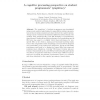Free Online Productivity Tools
i2Speak
i2Symbol
i2OCR
iTex2Img
iWeb2Print
iWeb2Shot
i2Type
iPdf2Split
iPdf2Merge
i2Bopomofo
i2Arabic
i2Style
i2Image
i2PDF
iLatex2Rtf
Sci2ools
DIAGRAMS
2004
Springer
2004
Springer
A Cognitive Processing Perspective on Student Programmers' 'Graphicacy'
The ‘graphicacy’ of student programmers was investigated using several cognitive tasks designed to assess ER knowledge representation at the perceptual, semantic and output levels of the cognitive system. A large corpus of external representations (ERs) was used as stimuli. The question ‘How domain-specific is the ER knowledge of programmers?’ was addressed. Results showed that performance for programming-specific ER forms was equal to or slightly better than performance for nonspecific ERs on the decision, naming and functional knowledge tasks, but not the categorisation task. Surprisingly, tree and network diagrams were particularly poorly named and categorised. Across the ER tasks, performance was found to be highest for textual ERs, lists, maps and notations (more ubiquitous, ‘everyday’ ER forms). Decision task performance was generally good across ER types indicating that participants were able to recognise the visual form of a wide range of ERs at a perceptual leve...
| Added | 01 Jul 2010 |
| Updated | 01 Jul 2010 |
| Type | Conference |
| Year | 2004 |
| Where | DIAGRAMS |
| Authors | Richard Cox, Pablo Romero, Benedict du Boulay, Rudi Lutz |
Comments (0)

